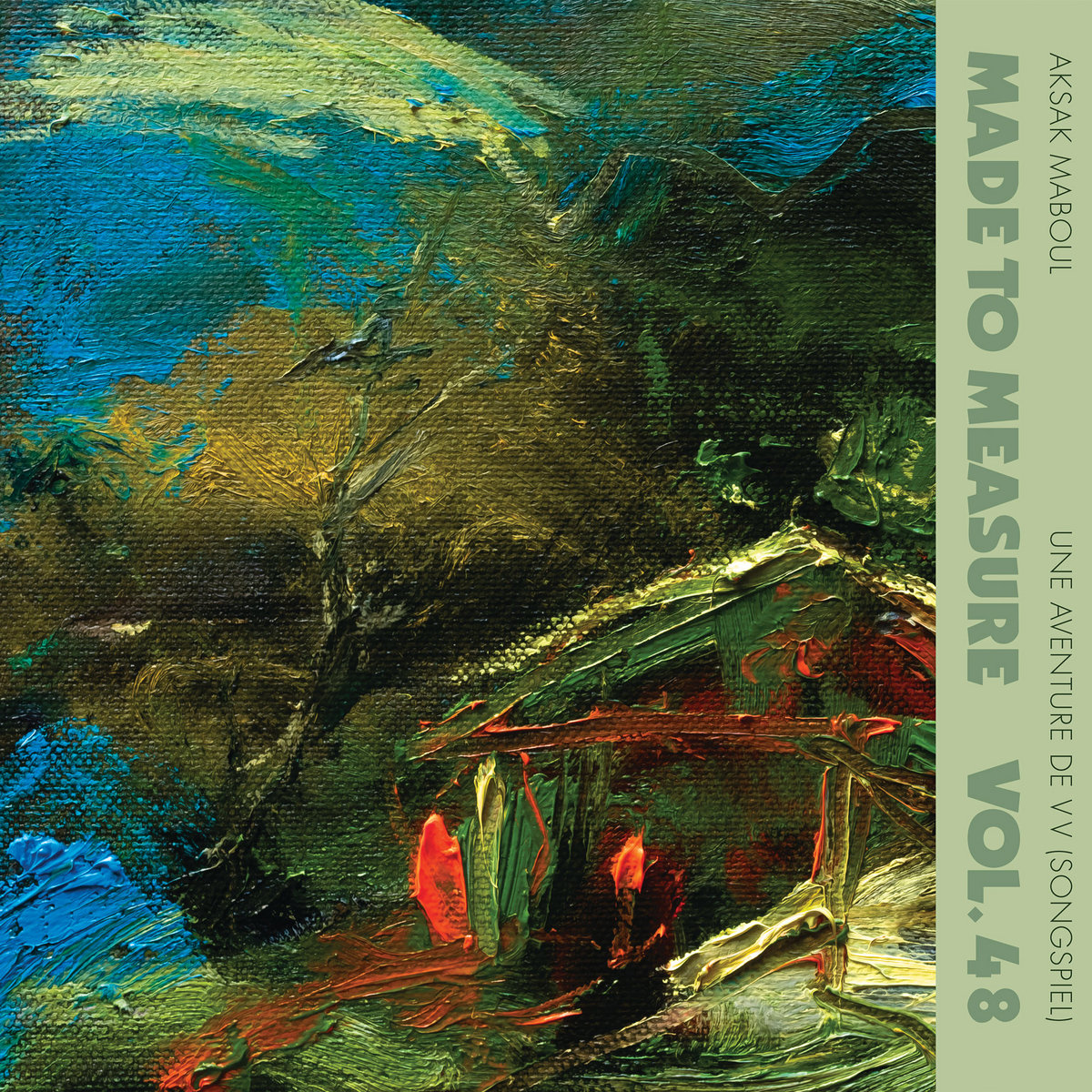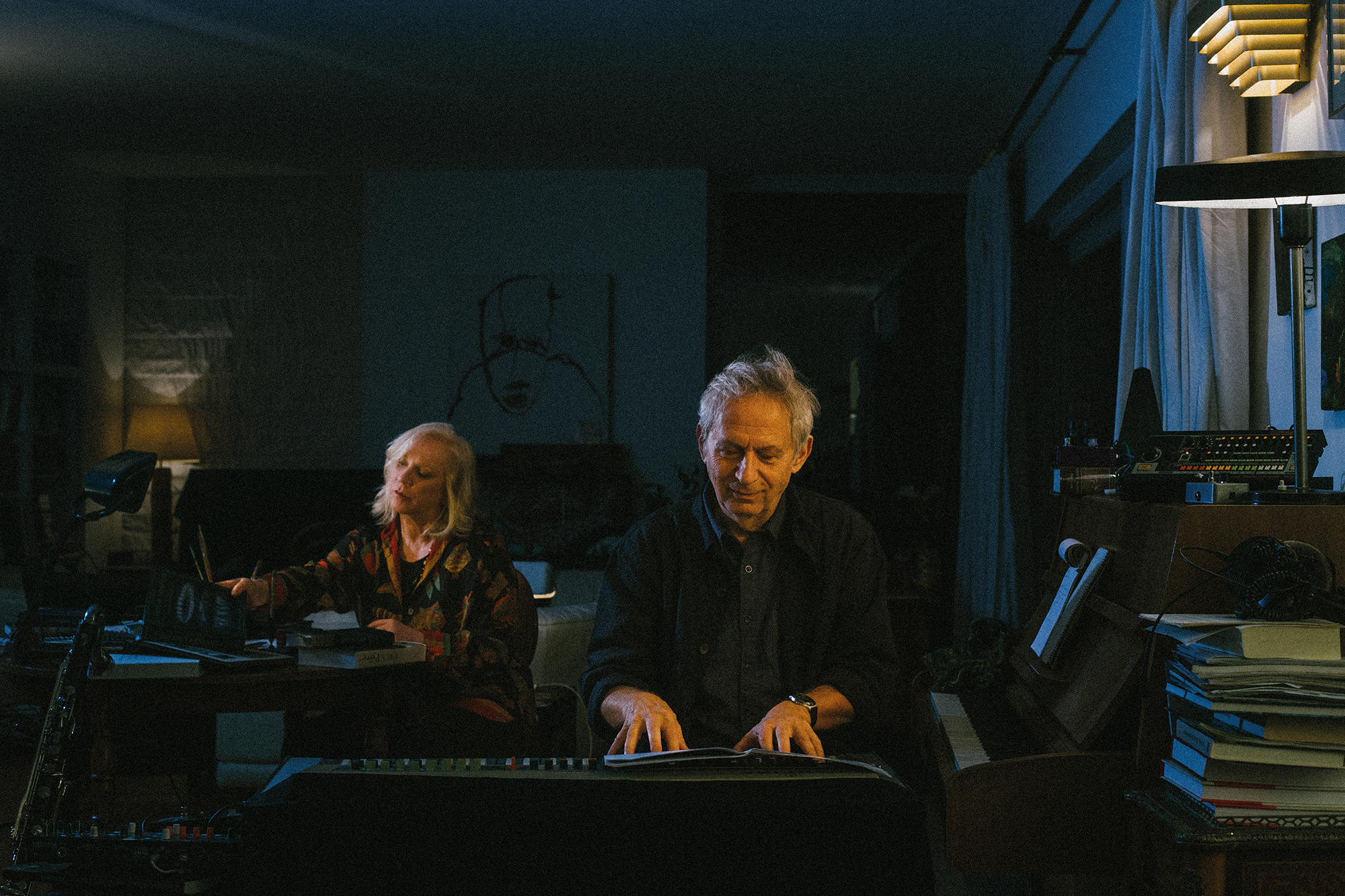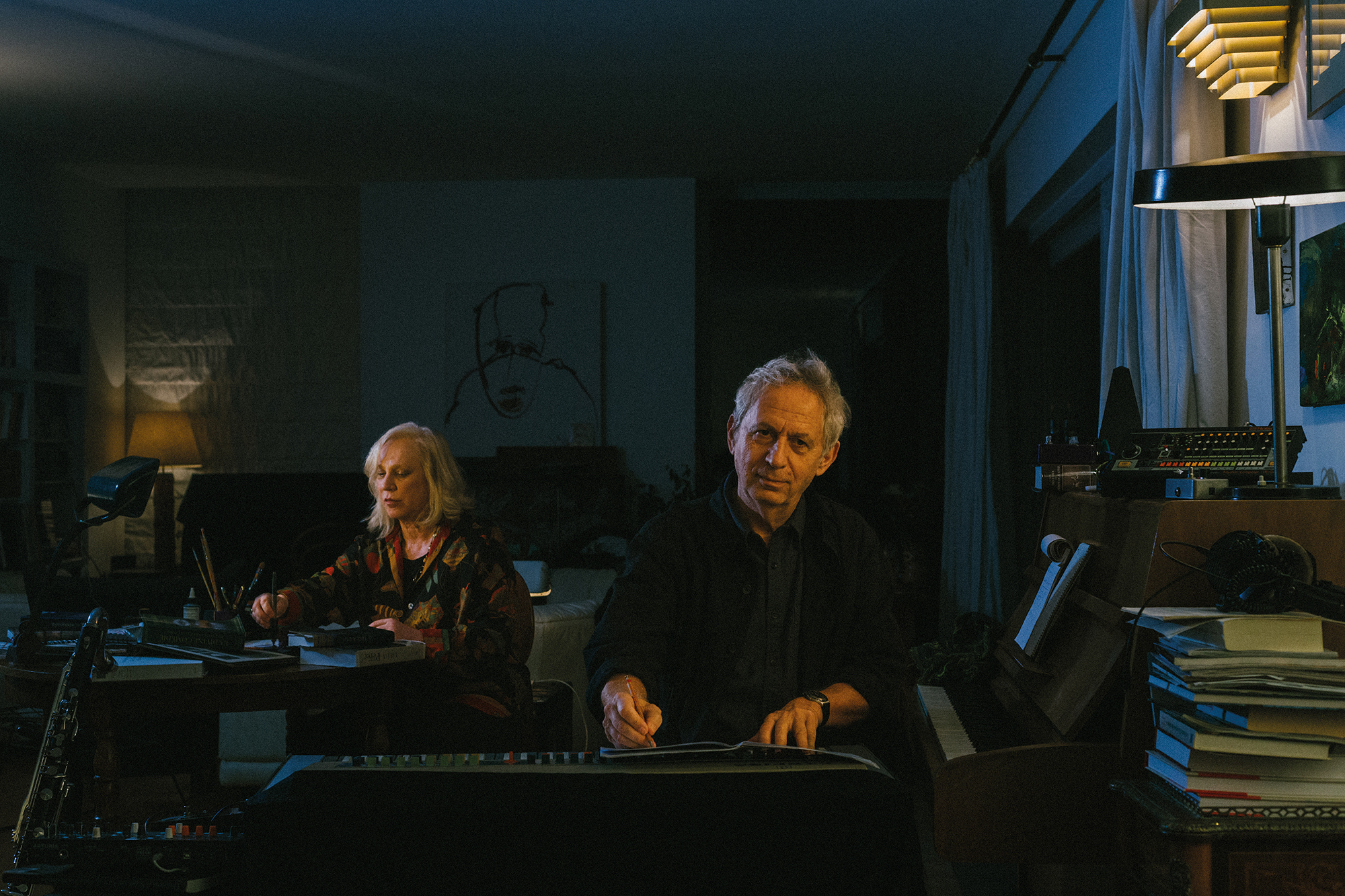Aksak Maboul | Interview | New Album, ‘Une Aventure De VV (Songspiel)’
Aksak Maboul’s fifth album, ‘Une aventure de VV (Songspiel)’ was recently released. The band’s core of Véronique Vincent and Marc Hollander took a playful sideways step to create this total work, a suite of fifteen pieces which can be described as an experimental audio play.
The thread running through ‘Une aventure de VV (Songspiel)’ is Véronique Vincent’s text, an enigmatic philosophical-poetical tale unfolding through monologues and dialogues, spoken and sung by a series of characters, alongside Véronique Vincent, who plays the main protagonist, VV. The characters are played by Lætitia Sadier (Stereolab), Blaine L. Reininger (Tuxedomoon), Alig Fodder, Audrey Ginestet and Benjamin Glibert (Aquaserge), Faustine Hollander and Don The Tiger. The music was written and performed by Marc Hollander, with contributions by the members of Aksak Maboul’s current live line-up.

“A journey with surprises at every turn”
How long did you work on your fifth album, ‘Une aventure de VV (Songspiel)’? Would you mind talking about the composition and how they evolved into the finished pieces?
Marc Hollander: We started in March 2020, during the first lockdown, at the beginning of the pandemic. This was before the release of the ‘Figures’ album. I basically set out without any preconceived plan, improvising on my keyboards and synths, drum machine et cetera. I wanted to further explore certain directions which were present in the previous album, and to push them further, without setting limits (such as trying to write songs). Within a couple of weeks, I had -to my amazement- basic elements for 8 pieces, which were started either by building rhythm tracks, or from piano improvs which I processed and built soundscapes around.
With Véronique Vincent, we then started thinking about various ways to incorporate vocals into the pieces. This obviously wasn’t going to develop into a song-based album, and the idea to use a lot of spoken words was appealing. There were already parlando sections in various places on ‘Figures’ (as well as in ‘Paysage Volé,’ the section we added to our old song ‘Le Troisième Personnage,’ when we started playing shows after the release of ‘Ex-Futur Album,’ in 2015. That song appears on the 16 ‘Visions of Ex-Futur’ remix/cover album). Using spoken words is something that Véronique likes doing and, in my view, her speaking voices can be quite captivating, in different ways than her singing voices. Shortly before working on ‘Une aventure de VV (Songspiel),’ we had done a rework of a track by Stubbleman, Griffith Park, with a text written and performed by Véronique, and we enjoyed that very much. We had also been performing an improv piece around a spoken poem by Henri Michaux.
We wanted to use a variety of ways to use speech, with different paces and modes of delivery that would match the music. Slow, fast, “natural” or “theatrical,” whispered or loud… Some with a flow devised by Véronique, some with precise rhythms “written” by me, and with a limited number of notes. Kind of like our version of sprechgesang .
During the following months, I wrote three more pieces, which called for more melodic singing. So we also had that. Singing, speaking, and “rhythmical sing-song” (sprechgesang-like).
The next idea which came up was for Véronique to write a story which would run through the whole album, and weave all these pieces and all the texts together. This was an exciting and amusing challenge. We devised a sequence for the very unfinished pieces, at that early stage, and Véronique set out to write the texts according to all these parameters (the sequence, and the succession of various styles of vocals).
Meanwhile, I pursued the production work on the tracks. Adding various arrangements, overdubbing instruments, improvising on top of tracks and then excerpting bits and turning them into compositional elements, using textures and field recordings, et cetera.
At various points, the need to add transitions or interludes at certain places was felt, in order to improve the flow of the musical narration, so we created them: I did the music, and Véronique imagined another segment of text which would fit in those precise spots of her story.
“Working on a large painting”
We were basically working simultaneously on the content of each piece and on the general architecture of the whole thing, which was a great thing. Maybe a bit like working on a large painting and taking care of details in various corners while integrating them in the big picture.
This also applies to the way we made some musical themes recur and punctuate the story. Such as the intro and the outro, and the various appearances of the theme from ‘Le Mur’.
As the final form started to emerge, we were more and more aware of the connection between the piece and certain forms which were used in the past: musical theatre, or experimental radiophonic plays which blended spoken literary content with music, experimental sound design et cetera.. Such as the pieces which were being made in the creative workshops of various European state radios: the BBC, the ORTF in France, the RAI in Italy all had these “labs” where experimental composers collaborated with writers et cetera. In Germany it was even a genre unto itself, the Hörspiel, which had its own festivals, its awards et cetera. A lot of these were probably simply radiophonic theatre pieces but, still, it reminded us of a pre-audiovisual era, where art forms had to be created that would work as audio-only, and would act on the audience in ways which are quite different that audio-visual stuff on TV or the net, as they leave a lot more to the listener’s own imagination and (visual) interpretation. We didn’t set out to do something like that, and I wouldn’t be as pretentious as to compare ourselves with some of these illustrious predecessors, but it was interesting to see a connection, and to be paying a kind of tribute to these forms (which by the way, are being somewhat revived in the world of podcasting).
Another comparison that came to our minds was -again, in an extremely modest way – with some early 20th century musical theatre pieces we had been enjoying for a long time, such as ‘L’Enfant et les Sortilèges’ (1925, music by Ravel, libretto by Colette) or ‘L’Histoire du Soldat’ (1917, music by Stravinsky, libretto by C.F. Ramuz). Again, there’s no comparing our little record with such masterpieces, but it was pleasing to feel that we drew a bit of inspiration from these works that had enchanted us.
Aside from some of the guest vocalists’ parts, and those of the guest instrumentalists (who all recorded their contributions in their own home studios), everything was recorded in our house, and mixed by Bob Hermans, who started out in his own home studio and came to complete the mixing with me at our place.
To what extent are you happy with the result?
Marc Hollander: We’re extremely happy from the reactions we’re receiving (from the audience and from the press). I understand that immersing oneself in the album does work as a kind of excursion into a different world, a journey with surprises at every turn (this notion came up in many of the reviews). But, as you can gather from my description of the process, it was first a journey for Véronique and I, as we didn’t know where we were going, and went from one pleasant surprise to another… The ‘Figures’ album was highly praised, and we’re at least as pleased with this album as we were with the previous one. At first, some people seem to be a bit hesitant to get fully into it because it’s a continuous piece, an “audio play,” or because the music might sometimes be a bit more experimental. But they’re rewarded when they do take the time to explore it, and realize that it’s also a collection of separate tracks, that there are enjoyable melodies and rhythms…we’ve even had reactions (and reviews) saying that this album is warmer and more welcoming than ‘Figures’! Which is fine with us… So, a great experience, all in all.
There’s a theme going through the album, a tale consisting of monologues and dialogues, spoken and sung by a series of characters. Would you mind sharing who the characters are and what they represent in this tale?
Véronique Vincent: The main character, “VV,” is a woman who, all of a sudden, is having trouble communicating with other people. She feels she needs to escape in order to find herself again. She embarks on a journey, walks and runs through various landscapes, meets a series of human and non-human characters whom she interacts with. At the end of her journey, she’s regained the use of language and is “back.”
The Tempest is a metaphorical character which doesn’t talk, but embodies VV’s state of mind: the world is drowning under layers and layers of words, and the storm scrambles up all the letters.
The Heron (played by Alig Fodder): he’s the voice of wisdom, he encourages VV and tells her that she’s on the right path.
Robin (played by Faustine Hollander) is like a guide who gives VV advice and directions.
The Voices of the Wood (Alig and Marc): all the other non-human beings in the forest (trees, stones, animals) join in and want to help her. They’re like benevolent spirits who are protecting her
The Tightrope Walker and the Scribe (Audrey Ginestet and Benjamin Glibert from Aquaserge) are spending an entire year creating a double analemma. When you mark the position of the sun at the same time every day, from the same spot, the figure obtained is called an analemma, it’s shaped like the ∞ sign (which symbolises infinity). I liked this idea and wanted to introduce characters who would spend their time drawing two infinity signs, side by side. This is how the idea of the tightrope walker came up, with her pendulum equipped with two spheres.
The Woman: We had the idea to sing a duet, Laetitia Sadier and I. I wrote this song with her in mind. VV and The Woman are two strong characters who set out to break down a massive wall, both real and symbolic (it can be viewed as representing any wall erected to oppress certain categories of people).
The Shadow (Don The Tiger): As she enters a dead, derelict zone, which is missing from the maps, VV finds comfort and strength in talking with her own shadow. When she comes under the shadow of something superior to herself, i.e. the shade of a giant tree, the shadow goes away.
The musicians who appear on the record were also given names of characters, though they only speak with their instruments…
A few words about the cover art: this album is part of the Made To Measure series, where it’s customary to use a pre-existing work of art as an illustration. In this case, I asked a friend of mine, great French painter Ronan Barrot, if he’d agree to paint a picture specially for the cover. He accepted, I told him about the story, and he interpreted it in his own way (one can recognise elements from the story, such as the orange cabin, a bird in a tree, the storm et cetera).
You had some truly incredible guest playing this characters, including Lætitia Sadier (Stereolab), Blaine L. Reininger (Tuxedomoon), Alig Fodder, Audrey Ginestet and Benjamin Glibert (Aquaserge), Faustine Hollander and Don The Tiger. Was it difficult to work with them or was the process pretty relaxed?
Véronique Vincent: It wasn’t difficult at all, as we sent them precise things to do, and each guest recorded his part at his place: Lætitia in London, Blaine in Athens, Alig in Crete, Don the Tiger in Berlin. Blaine and Adrián (Don The Tiger) had also respective improvised sections, which came out wonderfully. As for Audrey and Benjamin from Aquaserge and Faustine, they recorded their parts in our home studio, a lot of fun was had. Also very important were the contributions of the other two members of our live line-up, Lucien Fraipont (aka Robbing Millions), who recorded great guitar parts on several songs, and Erik Heestermans who ended up overdubbing drums and percussion on many tracks.
Tell us about the bonus material which also includes entire intros and outros to the pieces.
Marc Hollander: Because all the pieces on the album sequence one into another (there’s only one short break, after the 7th track), we eventually felt it would be nice for complete, non-crossfaded versions of some of the tracks to be made available to fans, and to radio broadcasters who would like to play certain songs from start to finish. The differences with the album versions aren’t huge but, for me of course, I like to also be able to listen to a song like ‘La Tempête’ for example, with its original introduction, those extra 25 seconds at the beginning. Or, for ‘Brown Dwarfs,’ to hear the complete 1-minute buildup which, on the album, starts at the end of the previous song, with which it is crossfaded. So there are five of these so-called standalone versions. They’re given as a bonus to anyone who buys the album on Bandcamp, along with a radio edit of La Parole de la peau, and a PDF of the complete booklet, with the texts and dialogues in their original and translated versions.
We should also mention the videos: we created fourteen visual illustrations, one for each of the tracks on the album. They’re not like music videos, more like abstract, dreamy takes on the moods of the pieces, which sometimes do relate to the lyrical content, and sometimes not. Almost all the footage was shot by Véronique, in a manner which defines the general atmosphere. She filmed a lot of plants, trees, stones…and also used some of her paintings.
The editing and processing was done by ourselves as well as by Silvia Baldan, the label’s graphic designer. Faustine Hollander and myself also shot some stuff, and I used various bits of vintage footage (things I filmed with a video camera a long time ago). This was a fun process, I personally enjoyed very much getting into editing these little semi-abstract films, the process is actually surprisingly close to that of producing music. The videos are all on a playlist on YouTube (link), if you go to the playlist you can actually listen to the whole album while watching the video illustrations.
Your ability to write such remarkable melodies to Véronique’s lyrics is truly amazing. How do you think you manage to do that? I mean, does it come naturally or what’s the creative process like between you two?
Marc Hollander: Thanks for your kind words… The music and the melodies generally precede the lyrics. The melodies derive from me improvising over the chords or beats I’ve laid down. These melodies flow “naturally,” if you like. They’re natural and obvious to me, but not always easy to sing, as I create them by playing on an instrument, not by singing.
Véronique then has the difficult task of writing lyrics which exactly fit the melodies, in terms of number of beats et cetera. She enjoys the process of having to cast her ideas into an existing mould. It’s a sort of creative constraint, which drives her to write things differently.
We sometimes also work the other way around: text first, melody later. Four of the songs on the ‘Figures’ album we made like that, I very much enjoy this method as well: I’m the one who has to deal with the constraint then, and it does drive me to write different types of melodies
So the process for writing melodies is always split in two (lyrics first or melody first), but we then work together to make some changes, adapt or modify the result.

What are some future plans for you now?
Marc Hollander: We’ve already started working on our sixth album, which is exciting. We’ll probably be playing some concerts in the autumn, including a small tour in Japan.
Klemen Breznikar
Headline photo: Véronique Vincent and Marc Hollander | Photo by Diego Crutzen
Aksak Maboul Facebook / Instagram / Twitter / Bandcamp
Crammed Discs Official Website / Facebook / Instagram / Twitter / Bandcamp
Aksak Maboul interview





Good interview, interesting group and an interesting album. Marc Hollander looks Ike a gracious man and an interesting artist.